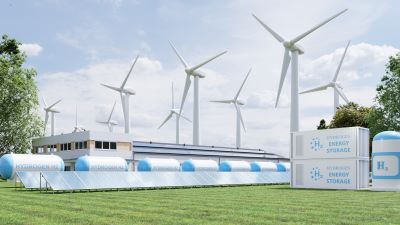Canada’s bioeconomy is a huge economic opportunity, but faces formidable challenges
 Canada has the abundant natural resources to build a thriving industrial bioeconomy but lacks commercial-scale bioreactors, a national strategy, and sufficient public and private investment, say experts in the sector.
Canada has the abundant natural resources to build a thriving industrial bioeconomy but lacks commercial-scale bioreactors, a national strategy, and sufficient public and private investment, say experts in the sector.
The bioeconomy is the use of biomass – such as crops, forests, fish, animals and micro-organisms – and biotechnology to make products that encompass food, health, materials, textiles and energy. Bio-based products are lower-carbon alternatives to products conventionally derived from petroleum.
When it comes to infrastructure, Canada is already losing innovative bio-based companies to other countries because of an acute shortage of large, commercial-scale bioreactors, stakeholders in the sector told a March 7 online conference, “BioDesign: Exploring Canada’s Strategic Position to the Global Bioeconomy,” presented by Lambton College in Sarnia, Ont., and Bioindustrial Innovation Canada.
“Other countries have this capacity and if we don’t have it, companies will move to where there is capacity,” said Beth Mason, CEO of the Verschuren Centre, a cleantech business accelerator based in Sydney, N.S.
The Verschuren Centre’s client companies often have to move to Europe or the U.S. when they scale to a stage that requires bioreactors of more than 10,000 litres to produce commercial products, Mason said. Without commercial-scale bioreactors in Canada, she added, “We have an amazing pipeline of innovation coming out of our universities with nowhere to land otherwise.”
“If we want to support manufacturing and greening the supply chain in Canada, then we can’t afford to lose the people who are making it [this green supply chain],” Mason said.
Canada has fewer than 10 large-scale bioreactors and many of these are less than 10,000-litre capacity, said Andrew Chiapetta, director of fermentation at Toronto-based Genecis Bioindustries Inc.. The company converts organic waste to biodegradable and compostable products that are environmentally alternatives to petroleum-derived plastics.
Northern California alone has more biomanufacturing facilities offered by contracting firms than in all of Canada, he said. “Commercial manufacturing facilities are something that we desperately need in Canada.”
“An increase in the number of these facilities will also reduce the brain drain that we’re seeing in Canada, and Ontario specifically. People are leaving for the [U.S.] because there are more opportunities, more jobs, more facilities like this where manufacturing is happening,” Chiapetta said.
Conference speakers said the federal government needs to offer incentives, such as tax credits, to Canadian investors to help de-risk investment in commercial-scale bioreactors, which can cost $50,000 to $200,000 and more.
Michael Dorrington, manager, strategic partnerships, at Toronto-based Ontario Genomics, said to help address the gap in infrastructure needed to support scale-up of bioprocesses, Ontario Genomics partnered with The Cultivated B, a Burlington, Ont.-based biotech firm, and Natural Products Canada, based in Charlottetown, P.E.I., to build a first-of-its-kind 25,000-sq-ft innovation hub in Burlington. The hub includes wet lab space for upstream process development, downstream processing equipment, and various-scaled bioreactors.
The Cultivated B, which is focused on cellular agriculture (producing agricultural products from cell cultures rather than whole plants or animals), is a German-Canadian company, with an R&D centre in Germany and a bio-engineering hub in Ontario.
Ali Nikdel, director of innovation at The Cultivated B, said there’s a long wait time for buying bioreactors – typically a year or two. Also, bioreactors now on the market aren’t energy efficient, are challenging for scaling up animal cells, and lack advanced monitoring and controls, he said.
Cultivated B’s vision, Nikdel said, is to establish medium-scale, highly automated bioreactor “farms,” with next-generation bioreactors ranging from 20,000 to 30,000 litres, rather than constructing and managing the more complex, very large bioreactors of 100,000 to 200,000-litre capacity.
Coordinated national bioeconomy strategy needed
Another thing missing in Canada’s bioeconomy is a coordinated national strategy, conference speakers said. More than 60 other countries – including the U.S., U.K., Germany and the European Commission – now have such a strategy.
“If we don’t have a larger vision, if we don’t have a strategy for this country, it’s going to make it much more difficult to build these industrial bioeconomy ventures in Canada,” said Meaghan Seagrave, executive director of Bioindustrial Innovation Canada.
The federal government did provide up to $200,000 in 2019 to Bioindustrial Innovation Canada to produce Canada’s first bioeconomy strategy document, which recommended creating a national bioeconomy strategy. However, no strategy was forthcoming.
Although there’s more interprovincial cooperation in the bioeconomy, “it’s not yet orchestrated fully in terms of a national linkage,” Mason at the Verschuren Centre said.
In 2021, Ottawa released Canada’s Biomanufacturing and Life Sciences Strategy, initially supported with a $2.2-billion investment. But this strategy is focused mainly on vaccines and other therapeutic medical biologics, and building manufacturing facilities for these products.
See also: Major hurdles confront Canada's Biomanufacturing and Life Sciences Strategy
Ontario Genomics’ Dorrington said the whole Canadian bioeconomy value chain needs to be integrated, including feedstock producers and managers, technology developers, end users, public and private funders, and training providers. “We must buy in to a common strategy.”
Kalsi Sukhdev, a professional engineer at Aylmer, Ont.-based DMT Bioproducts, which is developing bio-chemicals and bio-products, said for Canada’s bioeconomy system to develop, it needs to integrate academic research institutions, growers, industry, regulatory bodies and trade commissions.
Sandy Ferguson, senior advisor bioeconomy initiatives at Foresight Canada, said Canada has lots of potential just in the forest bioeconomy sector in producing products and materials from the sustainable processing of biomass, including trees, crops, grasses and algae.
More than 140 forest bioeconomy companies are innovating across Canada, she said. “It’s a pretty exciting technology value chain here in Canada that we have.”
However, Canada – unlike other countries such as Finland and the U.S. – lacks a formal “all-of-government” approach to supporting Canada’s bioeconomy sectors, Ferguson said. In the U.S., for example, the Biden administration has committed $2 billion to biomanufacturing.
Canada’s strengths and key assets include significant access to biomass, strong primary sectors with expertise, a skilled workforce and a growing bioeconomy, said Sue Coueslan, vice-president, strategies and partnerships, at Natural Products Canada.
The bioeconomy represents a $1-trillion opportunity for Canada, encompassing areas such as: water and waste treatment; bioproducts and sustainability; health, nutrition and wellness; animal health and nutrition; and food production and value-added agriculture, she said.
But to seize that opportunity, Canada’s bioeconomy needs to be recognized as a national priority with a whole-of-government commitment and a national framework that moves the country past jurisdictional silos, Couselan said.
Lack of “patient capital” in Canada is a big challenge
Another big challenge is the lack of “patient capital” in Canada, conference speakers said. Few investors are willing to invest in commercial bioreactors with high capital costs and in novel bioprocesses and bioproducts where return-on-investment takes a long time compared with other sectors such as information technologies.
“In order to reach the scale that we need to, there needs to be some incentive for investors to invest at that large scale – the big capital that’s going to be needed to build these plants,” said Wayne Maddever, advisor and portfolio manager for Bioindustrial Innovation Canada.
Government could offer incentives to help de-risk investment in commercial-scale bioreactors, he said. “But to this point, they [government] haven’t shown any more patience than a typical bank or investor.”
New “green,” low-carbon bioproducts – given the cost of R&D and the time it takes to develop them and obtain regulatory approval – are typically more expensive than long-established petroleum-derived plastics and other conventional products, Maddever said. “Unless there’s some sort of [government] incentive program to make up that difference in cost, it is always an uphill climb.”
The federal government used to offer such incentives for investors in Canadian public mining companies, he noted. “There’s no reason it couldn’t be done in this market as well, if we really wanted to.”
Canada also lacks seed capital investment that’s crucial for startups, Maddever said. “There’s just a complete lack of seed funding of enough magnitude to get these companies going.”
Government also could help by providing incentives to Canadian companies to purchase domestically made bioproducts and thereby support their production, said Sukhdev oft DMT Bioproducts.
There’s a $3-billion economic opportunity for Canada just for the three main biochemical product lines DMT is working on, he noted. “There’s a huge potential to reduce greenhouse gas emissions if we can scale up this technology in Canada.”
Another challenge is that, despite Canada’s strengths in university research and training graduates, there is a lack of “translational teams,” or workers with specific skills required to scale up from lab bench-level science to operating bioreactors and running bioprocesses. More training programs are needed, conference speakers said.
Canada’s bioeconomy is growing, but slowly and incrementally
Despite the formidable challenges, Canada’s bioeconomy players are investing and making progress – albeit slow and incremental – in growing the country’s bioeconomy.
Bioindustrial Innovation Canada is working to help companies locate to idle industrial sites, such as Bioindustrial Park Sarnia (former site of Polysar Corporation), and Bluewater Energy Park in Sarnia (former site of Dow Canada’s polyethylene plant). “We want companies in the bioeconomy to use these sites for commercial scale-up,” Maddever said.
To illustrate the challenges facing companies in the bioeconomy sector, Maddever pointed to the experiences of some of the companies in Bioindustrial Innovation Canada’s portfolio:
- EcoSynthetix, in Burlington, Ont., which produces bio-based latex polymers used for coatings and binders for the pulp and paper industry. The company is finally generating significant revenue – but no profits yet – nearly three decades after being established.
- LCY Biosciences, in Sarnia, which operates the largest food-grade fermentation plant for producing succinic acid, a bio-based chemical used in the automotive industry. One of the company’s key lenders called in its loan, triggering bankruptcy. LCY, a Korean company, bought the firm, which continues to operate.
- Ardra Bio, in Toronto, which uses synthetic biotechnology to produce flavours and fragrances, including the protein heme for plant-based meat alternatives. The company has struggled due to lack of seed funding and scale-up facilities in Canda.
- Comet Bio, in London, Ont., which creates C5 sugars (which can be converted to fuels) from biomass. The company received little or no support in Canada, so moved to Europe where the firm is being acquired by a partner.
Coueslan said Natural Products Canada (NPC), which is focused on investing in and supporting early-stage bio-based companies, has so far invested $6.3 million into 75 early-stage firms.
For NPC’s portfolio companies, over three years this investment has created 306 new jobs (a 121-per-cent increase), generated $153 million in revenue (up by 1,030 per cent), and increased companies’ exports by 52 per cent, she said. After NPC’s investment, the companies attracted $409 million of follow-on investment from private foreign and Canadian investors.
NPC-supported companies include:
- Canbiocin, in Edmonton, which makes powerful species-specific probiotics for companion animals.
- Dispera, in Laval, Quebec, is transforming food waste into biosurfactants for cleaning and personal care.
- Bast Fibre Technologies, in Victoria, B.C., is creating sustainable fibres from crops like hemp to make compostable wipes and other products.
“The right kind of advice, the right kind of connections, and the right kind of capital at those early stages can really make the difference for these companies,” Coueslan said.
The Canadian Bio-Cleantech Applied Research Network (CBARN), an academic network funded over two years by the Federal Economic Development Agency for Southern Ontario (FedDev) has helped 65 companies since the network started in July 2022, said Rob Nicol, manager of the Bio-Industrial Process Research Centre at Lambton College and of CBARN.
The network, which includes five Ontario colleges and Western University’s Institute for Chemicals and Fuels from Alternative Resources, is able to produce bio-based natural health products, food ingredients and pharmaceuticals in the network members’ bioreactors. The network also has facilities to work with regulated toxins, microbes and cell lines requiring Containment Level 2.
Nicol said that in 20 months, CBARN has: supported 26 new businesses; commercialized 36 processes or products; improved 96 processes or products; and created 56 permanent jobs. FedDev funding for CBARN ends this month.
Ontario Genomics has started the BioCreate program, supported by FedDev, where startup companies can receive up to $150,000 of non-dilutive funding, and access to accelerators, mentoring and coaching for 18-month projects.
To increase the bioeconomy workforce, Ontario Genomics has sponsored the development of micro-credential programs with Lambton College and Loyalist College, and hands-on bioreactor training with Lambton College and Cultivated B.
Through genomics and bio-engineering, living organisms have produced the spike protein and coating used in mRNA vaccines against COVID-19, iron-binding “heme” protein for plant-based meat alternatives, and bio-engineered silk for textiles.
“Through genomics innovations, Canada is now home to the first dairy cow breeding program that can select for higher feed efficiency and less methane production, making agriculture more sustainable,” said Dorrington of Ontario Genomics.
There’s a potential $7.5-billion economic opportunity for Canada, including 86,000 jobs, just in cellular agriculture by 2030, he said.
In addition, new cell and gene therapies are being approved for patients to treat genetic diseases, cancers and more. According to reports by McKinsey, 45 per cent of the world’s disease burden will be addressed by biologics, and 60 per cent of basic materials replaced with biologics by 2050.
McKinsey predicts the “bio-revolution” could generate $4 trillion a year between 2030 and 2040 – at least half of that in the industrial bioeconomy.
Noted Natural Products Canada’s Coueslan: “We’re not just trying to seize a market opportunity. This really is about shifting to products and processes that ensure the health and survival of the planet.”
R$
Events For Leaders in
Science, Tech, Innovation, and Policy
Discuss and learn from those in the know at our virtual and in-person events.
See Upcoming Events
You have 0 free articles remaining.
Don't miss out - start your free trial today.
Start your FREE trial Already a member? Log in
By using this website, you agree to our use of cookies. We use cookies to provide you with a great experience and to help our website run effectively in accordance with our Privacy Policy and Terms of Service.





